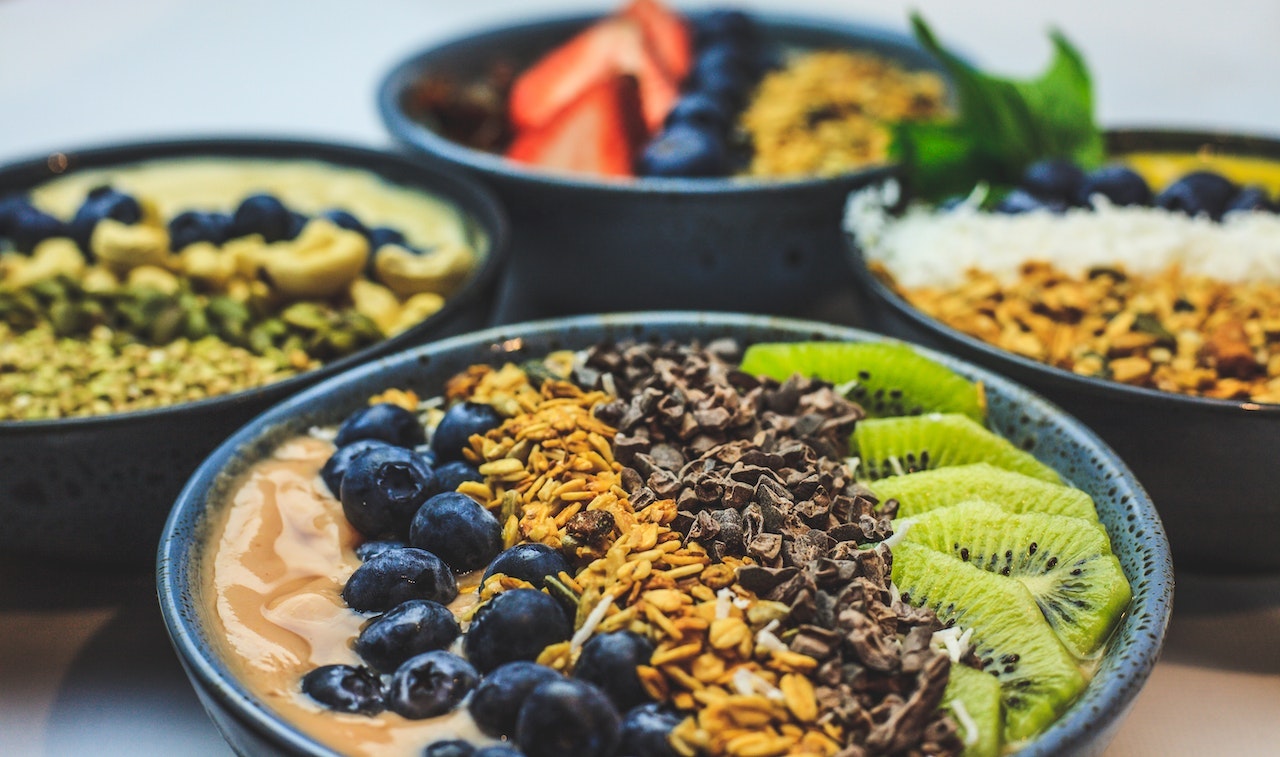Açaí bowls are healthy and nutritious, but can be high in sugar. To fully reap the health benefits, it's important to carefully select ingredients, control portion sizes, and minimize added sugars while preparing or purchasing an açaí bowl.
When made with nourishing components and enjoyed in moderation, these bowls can be both nutritious and delightful. By adhering to these guidelines, you can indulge in this delicious treat without compromising your well-being.
What is an Açaí Bowl?
Originating in Brazil, the açaí bowl is made of frozen açaí palm fruit that is puréed and served as a smoothie in a bowl or glass.
Açaí bowls have stolen the limelight in the world of superfruit health foods. When it comes to visual appeal, açaí bowls usually boast attractive, eye-popping masterpieces that vary in texture, taste, and nutrients. However, the nutrition, or lack thereof, does not necessarily lie in the artfulness of the creation but in the toppings.
Determining the nutritional value of an açaí bowl can be difficult due to the absence of a standardized recipe or universally accepted list of ingredients. Consequently, the calorie count, sugar content, fat and protein levels, as well as antioxidant, vitamin, and mineral content will vary depending on how the açaí bowl is made and the portion size.
Nutrients in Pure Wild-Harvested Açaí Purée
You may be surprised to learn that açaí berries themselves are naturally sugar-free. Their nutrition facts differ significantly from most fruits, as they are much higher in fat and contain no sugar. Anyone who has tried unsweetened açaí puree won't be too shocked, considering their deliciously unique, bitter flavor.
According to the USDA, 100 grams of pure açaí berry purée (slightly less than a ½-cup serving) provides the following nutrition:
- Calories: 60
- Fat: 5g
- Sodium: 7mg
- Carbohydrates: 6g
- Sugars: 0g
- Fiber: 3g
- Protein: 2g
- Potassium: 105mg
- Iron: 0.6mg
- Calcium: 40mg
- Vitamin A: 1000IU
Furthermore, açaí is widely regarded as a “superfruit” with added health benefits because it contains an abundance of antioxidants. These antioxidants include phenolic acids, flavonoids, tannins, carotenoids, and anthocyanins.
Are Açaí Bowls Healthy?
Creating a healthy açaí bowl is entirely possible by carefully selecting the toppings. Açaí berries themselves are inherently nutritious, but it's important to be mindful of the additional ingredients used. When preparing your own açaí bowl, you have full control over the level of sweetness by avoiding any extra sweeteners and opting for lower-sugar options like berries and melon instead of bananas and mangoes if you're watching your sugar intake.
A carefully crafted basic açaí bowl provides significant percentages of the daily value of many essential vitamins and minerals, including vitamin C, potassium, iron, vitamin E, and even vitamin K—a nutrient difficult to get in your diet.
However, it is crucial to exercise moderation when adding toppings and limit high-calorie choices if weight loss is your goal. Additionally, keeping an eye on portion sizes will help you maintain control over your sugar, carbohydrate, and calorie consumption.
In summary, with conscious topping choices and portion awareness, you can enjoy a delicious yet healthy açaí bowl while managing your dietary needs effectively.
Are Commercially Available Açaí Bowls Healthy?
Often, the makers of commercial açaí bowls focus more on the visual appeal to catch the eye of the consumer, without prioritizing the nutritional value of the products. Therefore, when compared to homemade açaí bowl recipes, commercially sold versions at smoothie shops often contain more sugar and calories, making them less healthy. The serving of commercial açaí bowls are typically oversized.
In addition to açaí berries, this popular dish typically incorporates other antioxidant-rich fruits like blueberries, strawberries, raspberries, and blackberries. These various berries contribute valuable compounds such as anthocyanins which provide numerous health benefits for individuals consuming these nutritious bowls.
However, although açaí berries are sugar-free, it's important to note that other fruits, often considered healthy options, do contain sugar. Consequently, when combined in an açaí bowl, the overall sugar content can become quite high.
A perfect example to look at and compare is the Jamba Acai Primo offered by Jamba Juice. The ingredients in the Jamba bowl are strawberries, açaí blend, blueberries, soy milk, bananas, organic granola, honey, and shredded coconut.
- Calories: 520
- Fat: 11g
- Sodium: 45mg
- Carbohydrates: 103g
- Sugars: 65g
- Fiber: 11g
- Protein: 8g
- Potassium: 850mg
Despite containing 11 g of fiber, nearly half of the recommended daily intake, this Jamba bowl is high in sugar with a staggering 65 grams.
Bottom Line
While commercially available açai bowls offer nutritional benefits and antioxidant properties, they often come in oversized servings and contain excessive amounts of added sugar and calories.
By preparing your own açaí bowl at home, you have the advantage of being able to regulate portion sizes according to your needs. This empowers you to take charge of the ingredients that go into your bowl, enabling you to make healthier choices and maintain control over your dietary intake.
Additional Açaí Bowl Questions
How many calories are in an açaí bowl?
- Açaí bowls have the potential to be high in calories because they consist of açaí base, various toppings, and optional extras. It is important to be mindful of portion sizes as consuming a large bowl with excessive toppings and additional ingredients may lead to increased calorie intake. While a pure Acai purée bowl weighing 100g contains 60 calories, the addition of toppings can significantly raise the calorie count to 600 or even higher.
Do açaí bowls have antioxidants?
- Acai berries are known to be rich in various antioxidants, including anthocyanins, vitamin C, polyphenols, phenolic acids, flavonoids, tannins, carotenoids, and vitamin E. Antioxidants combat oxidative stress and inflammation, support the immune system, have anti-inflammatory properties, promote cardiovascular health, have anti-aging effects, and promote skin health.
Do açaí bowls contain dietary fiber?
- Açaí bowls are rich in fiber that benefits digestive health and can help regulate bowel movements.
Are açaí bowls high in potassium?
- Acai Bowls contain significant amounts of potassium, a vital nutrient that helps regulate blood pressure and provides protection against age-related bone loss and kidney stones.
Which antioxidant-rich berries can be used as açaí bowl toppings?
- In addition to açaí, other berries often found in an açaí bowl are blueberries, strawberries, raspberries, and blackberries. These berries are rich in antioxidants like anthocyanins which offer various health benefits.
Why do commercial açaí bowls typically have added sweeteners?
- Acai berries are not naturally sweet, so many commercial or prepared açaí bowls have higher-sugar fruits, added sweeteners like honey or agave, and granola that is packed with added sugar and oil.
How do I limit the sugar content of an açaí bowl?
- By crafting your own açaí bowl, you have the power to regulate the sugar content. Simply avoid adding extra sweeteners and choose lower-sugar options like berries and melon instead of bananas and mangoes if you wish to reduce your sugar consumption. This way, you can maintain control over the level of sweetness in your bowl while still enjoying its delicious flavors.
Why should you add protein and healthy fats to your açaí bowl?
- To enhance the feeling of fullness and regulate the release of sugar into your bloodstream, it is advisable to incorporate a protein source into your açaí bowl. Nuts, seeds, or nut butter are all excellent choices as they not only offer protein but also provide healthy fats and a touch of fiber.
Consider pecans, walnuts, almonds, pistachios, cashews, macadamia nuts, flaxseeds, sunflower seeds, hemp seeds, pumpkin seeds, Chia seeds, a tablespoon of almond butter or peanut butter, or other similar ingredients. Another option is to include unsweetened shredded coconut, which adds healthy fats to your bowl. - If you're looking for more protein in your açaí bowl, consider blending the açaí berries with Greek yogurt or unsalted cottage cheese. This will not only increase the protein content but also add volume to the mixture.
- Additionally, depending on your caloric requirements and dietary preferences—whether you're having an açaí bowl for breakfast, lunch or as a lighter snack—you can opt for incorporating high-quality protein powder into the smoothie portion of your dish to boost its satiety effect and provide additional protein.
What to add to an açaí bowl for a bit of crunch?
- For a delightful crunch in your açaí bowl, skip the usual sugary granola and opt for unsweetened muesli instead. Muesli is a combination of oats, seeds, whole grains, and dried fruits that offers a chewier texture compared to granola since it isn't coated in honey and oil.
- If you're craving an extra crunch factor, you can include Grape Nuts cereal or amp up the seed and nut content.
- Another fantastic option is pomegranate seeds, which provide both juiciness and a satisfying crunch while delivering an abundance of antioxidants and vitamin C.
So go ahead and experiment with these crunchy additions to elevate your next bowl of goodness!


Comment